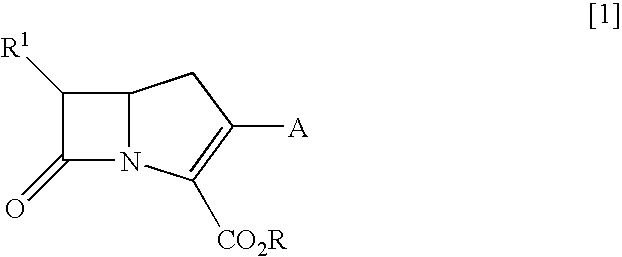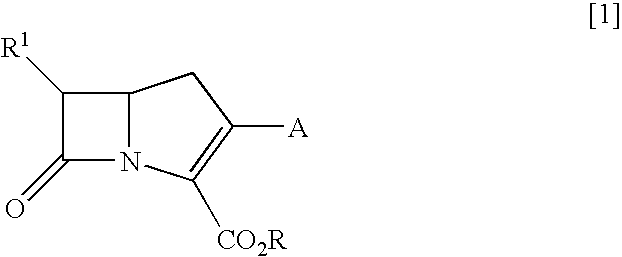Novel Carbapenem Compound
- Summary
- Abstract
- Description
- Claims
- Application Information
AI Technical Summary
Benefits of technology
Problems solved by technology
Method used
Image
Examples
example 1
[0136]
[0137] Allyl (5R,6S)-3-(4-allyloxycarbonyl-3-oxo-3,4-dihydro-2H-1,4-benzoxazin-6-yl)-7-oxo-6-{(1R)-1-hydroxyethyl}-1-azabicyclo[3.2.0]hept-2-ene-2-carboxylate (0.36 g, 0.67 mmol) obtained by referential example 3 and dichloro bis(triphenylphosphine)palladium(II) (23 mg, 0.034 mmol) were dissolved in methylene chloride (7 ml), and thereto was added at 0° C. tri n-butyltin hydride (2.7 ml, 10 mmol), followed by stirring for 30 minutes. To the reaction mixture was dropped aqueous hydrogen sodium solution (0.13M, 10 ml), and the aqueous layer was washed with diethyl ether and separated with a separating funnel. After part of the aqueous layer was concentrated in vacuo at 0° C., the residue was purified with C18 reverse column chromatography (filler: Wako Pure Chemical: Wakosil 40C18, mobile phase; 0 to 3%THF / ice cooled ion exchanged water). The combined fraction containing the object compound was stirred at room temperature in vacuo for 1 hour. After removal of THF the residue was...
example 2
[0139]
[0140] Sodium (5R,6S)-3-(3-oxo-3,4-dihydro-2H-1,4-benzoxazin-6-yl)-6-[(1R)-1-hydroxyethyl]-7-oxo-1-azabicyclo[3.2.0]hept-2-ene-2-carboxylate (0.14 g) obtained by Example 1 was dissolved in dry DMF (1.4 ml), and to the solution was gradually dropped under ice-cooling pivaloyloxymethyl iodide (98 mg), followed by stirring. One hour later, ethyl acetate was added thereto and the solution was washed with sodium hydrogen carbonate, water and brine. The organic layer was dried over anhydrous sodium sulfate and concentrated. The residue was purified by silica gel column chromatography (hexane: ethyl acetate=1:1→1:3) to give (2,2-dimethylpropanoyl)oxymethyl (5R,6S)-3-(3-oxo-3,4-dihydro-2H-1,4-benzoxazin-6-yl)-6-[(1R)-1-hydroxyethyl]-7-oxo-1-azabicyclo[3.2.0]hept-2-ene-2-carboxylate (0.11 g, yield 68%).
[0141]1H NMR (400 MHz, CDCl3) δ1.19 (s, 9 H), 1.37 (d, 3 H, J=6.3 Hz), 1.80 (d, 1 H, J=4.8 Hz), 3.18-3.35 (m, 3 H), 4.22-4.30 (m, 2 H), 4.63 (s, 2 H), 5.78 (d, 1 H, J=5.5 Hz), 5.85 (d, ...
example 3
[0142]
[0143] Allyl (5R,6S)-3-(1,3-diallyloxycarbonyl-2-oxo-2,3-dihydro-2H-benzimidazol-5-yl)-7-oxo-6-{(1R)-1-hydroxyethyl}-1-azabicyclo[3.2.0]hept-2-ene-2-carboxylate (0.56 g, 1.0 mmol) obtained by referential example 7 and dichloro bis(triphenylphosphine)palladium(II) (18 mg, 0.025 mmol) were dissolved in methylene chloride (35 ml) and thereto was added at 0° C. tri n-butyltin hydride (4.4 g, 15 mmol), followed by stirring for 20 minutes. Thereto was dropped aqueous sodium hydrogen carbonate solution (0.20M, 10 ml). The aqueous layer was washed with diethyl ether and separated with a separating funnel. After part of the aqueous layer was concentrated in vacuo at 0° C., the residue was purified by C18 reverse column chromatography (filler: Wako Pure Chemical: Wakosil 40C18, mobile phase; 0 to 2% THF / ice-cooled ion-exchange water). The combined fraction containing the object compound was stirred at room temperature in vacuo for 1 hour. After removal of THF the residue was lyophilized...
PUM
| Property | Measurement | Unit |
|---|---|---|
| Time | aaaaa | aaaaa |
| Antimicrobial properties | aaaaa | aaaaa |
Abstract
Description
Claims
Application Information
 Login to View More
Login to View More - R&D Engineer
- R&D Manager
- IP Professional
- Industry Leading Data Capabilities
- Powerful AI technology
- Patent DNA Extraction
Browse by: Latest US Patents, China's latest patents, Technical Efficacy Thesaurus, Application Domain, Technology Topic, Popular Technical Reports.
© 2024 PatSnap. All rights reserved.Legal|Privacy policy|Modern Slavery Act Transparency Statement|Sitemap|About US| Contact US: help@patsnap.com










